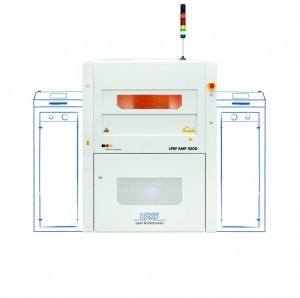A new solution from LPKF makes it possible to produce housing-integrated antennas in SiPs in a time and space-saving manner. The process, called Active Mold Packaging (AMP), works with Laser Direct Structuring (LDS). The lasered areas are then selectively metallized with copper.
For RF applications in the consumer electronics, automotive and aerospace industries, Active Mold Packaging (AMP) is a space-saving, simple and reliable process for integrating planar antennas directly into or onto packages.
The new process in the field of assembly and packaging technology (AVT) for the production of integrated circuits (ICs) converts previously unused volume of the epoxy mold compound (EMC) of an IC into an active carrier of the electrical functionality.
AMP enables additional metallization layers on the surface and in the volume of the EMC and thus offers a new development approach for high-frequency applications - especially in the mm-wave range. The technology is based on three proven and standardized electronics manufacturing technologies:
- Encapsulation of the EMC
- Laser processing using Laser Direct Structuring (LDS)
- Selective metallization of the lasered areas with copper
The technology offers a resolution of 25 µm line width and spacing. This means that minimum pitches of just 50 µm can be achieved.
With regard to the design and manufacture of mmWave antennas in ICs and also so-called system-in-packages (SiPs), the AMP process is a forward-looking alternative to previous approaches. One advantage of the innovative process is the direct connection to the underlying encapsulated circuit. Cable lengths and impedance can be designed and tuned more easily. These optimization options also reduce the parasitic capacitances and inductances of the circuit. Other reliability and service life problems resulting from more complex connections between the antenna and feed line in other processes are greatly minimized thanks to AMP. Fig. 2: The laser system for manufacturing antennas on EMC compounds: LPKF AMP 3000
Fig. 2: The laser system for manufacturing antennas on EMC compounds: LPKF AMP 3000
AMP covers a wide range of RF applications - applications related to 5G technology as well as 'beyond 5G' (B5G) - also known as 6G - RF technologies. They include waveguides and striplines as well as mmWave antennas as antenna-in/on-package (AiP/ AoP) modules. These operate, for example, in the sub6GHz, 24 GHz, 61 GHz and 121 GHz ISM bands.
The technology can also be used to realize automotive radar modules that operate between 76 GHz and 81 GHz as well as 5G amplifiers or EMC shielding. Other applications for the process include package-on-package (PoP), 2L interposers, multi-chip modules (MCM), thermal management and SiP connections.


